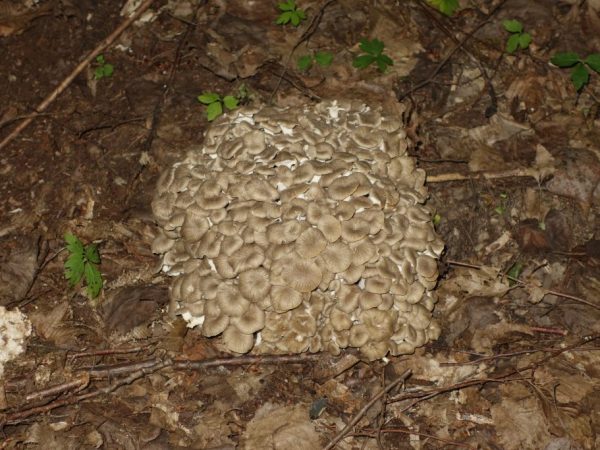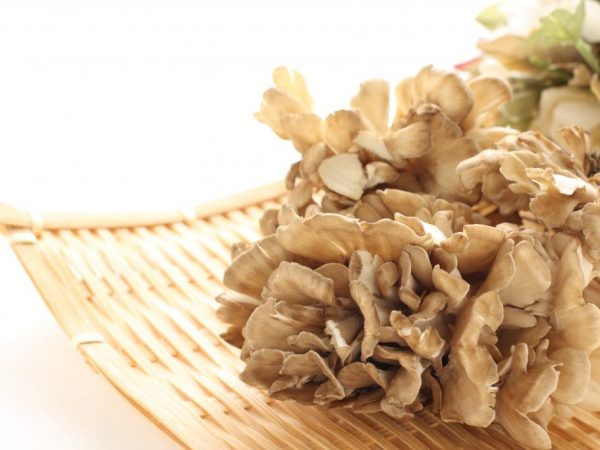Description of the mushroom ram
The ram mushroom, or curly griffin, is an edible and rare species. It lives in broadleaf forests, at the base of old oaks, maples, chestnuts and beeches, and grows rapidly and thrives. The collection is carried out in August and September. The mushroom is listed in the Red Book of Russia.

Description of the mushroom ram
Description of the appearance and geography of distribution
The ram mushroom looks like a giant representative of the Mushroom kingdom, which has absorbed dozens of small mushrooms. It has a large fruiting body, which can reach 40-50 (and sometimes 80) cm in diameter and weigh up to 10 kg. The shape can be either spherical or irregular. From the central part - a short thick "hemp", many thickened branching legs grow, which end in caps of various shapes: shovel-shaped, tongue-shaped, round and semicircular. The width of one such leg varies from 3 to 11 cm, and the thickness can be up to 1 cm.
Each cap of the griffin mushroom is curly, usually fleshy and leathery, with wavy edges, tapering to a wedge near the stem. The upper part of the cap becomes beige or gray-brown in color, while the lower surface is usually painted white. The fleshy part of the griffin is light, brittle in structure, characterized by rich aroma and nutty flavor. Spores are usually ellipsoidal, the spore powder formed by them is white.
Irina Selyutina (Biologist):
The ram mushroom lives in deciduous and mixed forests at the base of the trunks of already old deciduous trees. Causes the appearance of white rot in trees.
By the way. Fruit bodies are solitary, not formed every year.
Curly griffin is listed in the Red Book of the Russian Federation, where it is assigned the 3rd category - a rare species. It is also included in the Red Data Books of the Oryol (category 1) and Lipetsk (category 3) regions. The species is prohibited from collection, much less destruction. One of the habitats of the species known to mycologists is located on the territory of the State Memorial and Natural Reserve “Museum-Estate of Leo Tolstoy“ Yasnaya Polyana ”.
The factors limiting (limiting) its distribution include:
- selectivity to the substrate;
- confinement to old-growth deciduous forests;
- habitat destruction due to deforestation;
- removal of fallen trunks;
- collection of fruit bodies by the population.
Other names are curly griffin, meytake, dancing mushroom, leafy tinder fungus, leafy tinder fungus, lamb head.
Mushroom composition
Due to its rich chemical composition, the ram head mushroom has many beneficial properties. Meitake composition:
- proteins - 1.95 g,
- fats - 0.18 g,
- carbohydrates - 8 g,
- dietary fiber - 2.6 g,
- water - 90.5 g,
- ash elements - 0.52 g,
- potassium - 205 mg
- phosphorus - 73 mg,
- magnesium - 11 mg,
- calcium - 2 mg,
- sodium - 2 mg,
- zinc - 0.76 mg,
- iron - 0.2 mg,
- manganese - 0.07 mg,
- selenium - 2.3 mcg,
- copper - 0.26 mcg.
The mushroom has a rich vitamin complex:
- nicotinic acid (niacin, PP) - 7.18 mg,
- ascorbic acid (vitamin C) - 2.2 mg,
- riboflavin (lactoflavin, vitamin B2) - 0.25 mg,
- thiamin (vitamin B1) - 0.14 mg,
- tocopherol (vitamin E) - 0.02 mg,
- calciferol (a combination of calcium and vitamin D) - 28.2 mcg,
- cyanocobalamin (vitamin B12 ) - 0.03 μg.
The chemical composition of meitake includes a set of amino acids required by the human body. This includes:
- Irreplaceable: valine, lysine, leucine, isoleucine, tryptophan, phenylalamine, threonine, methionine.
- Conditionally irreplaceable: cystine, histidine, alanine, tyrosine.
- Replaceable: proline, glutamic acid, arginine, aspartic acid, glycine, serine.
The main properties of the mushroom

The mushroom has anti-tumor properties
According to the description, the mushroom has vivid lebanese properties:
- Immunomodulatory property: Meitake is capable of both inhibiting the development of the immunodeficiency virus and destroying it. Stimulates resistance to infectious and seasonal diseases.
- Stabilizing action: optimization of protein metabolism in the body, regulation of blood glucose levels, stabilization of blood pressure, improvement of the thyroid and adrenal glands, reduction of pain in premenstrual syndrome and menopause, normalization of bile synthesis.
- Antineoplastic action: influences tumors of both benign and malignant origin, inhibiting their viability.
- Medicinal properties: the fungus resists viruses, bacteria and fungi. It is highly effective for hepatitis B and C, chickenpox, herpes, Ebola, malaria, tuberculosis, mycoplasmosis and other diseases.
- Takes an active part in removal of toxic substances and toxins, including cholesterol.
- Highly prized griffin curled as cosmetic product to cleanse the pores and gradually narrow them, to optimize the activity of the sebaceous glands.
- Regenerative property fungus is used in the treatment of liver cirrhosis and stimulation of the growth of new hepatocytes (liver cells).
- Curly griffin is able to provide blocking action on the cells of adipose tissue, which then do not have the ability to be deposited in the tissues.
Contraindications
The lamb's head mushroom is not only healthy, but also safe. Despite this, there are some restrictions on its use for treatment. Among the restrictions, the appearance of an allergic reaction and intolerance to certain components, as well as age up to 12 years, are noted.
Pregnant women and nursing mothers should refuse to eat the mushroom during the period of gestation and breastfeeding, since meitake lowers blood glucose levels. It should be used with great care by patients with diabetes mellitus. The ram's head mushroom lowers blood pressure, so it should not be consumed by hypotensive patients.
Cooking applications
Grifola has pleasant taste and aroma, so it should be added as a component of many dishes from meat, fish and vegetables.
Miso soup
Miso soup is one of the popular traditional Japanese dishes.
Its preparation:
- Bring 2 liters of water to a boil, add 4 tbsp. l. special pasta for miso, 2 tbsp. l. soy sauce, and then - up to 400 g of meitake mushrooms, 2 pcs. leeks, 7-10 stalks of green onions, tofu cubes, nori seaweed pieces.
- All ingredients are brought to a boil for 2 minutes.
- To add flavor, it is allowed to add 3 tbsp. l. rice wine.
Fried chicken breasts with meitake and wine sauce
Cooking sequence:
- Rub 800 g of chicken breasts with a mixture of pepper and salt, then fry in oil for up to 8 minutes on the side where the skin is, then spread on a baking sheet.
- About 500 g of mushrooms are soaked in the remaining oil and placed next to the chicken to bake for half an hour.
- Melt 1 tbsp. butter, add 1 tbsp. l. flour, 110-120 ml of chicken broth, bring to a boil in a separate bowl.
- Pour in 250 ml of dry red wine, salt, pepper and sugar to taste. All this is boiled for 10 minutes.
Roast beef with meitake and soy cream sauce
We cook sequentially:
- 200 g of beef meat is cut into thin slices, sprinkled with salt and pepper.
- Prepare 150 g of mushrooms (while the meat is marinated).
- In a frying pan in 2 tbsp. l. vegetable oil for 4 minutes, fry the meat. Separately melt 10 g of butter, fry the mushrooms for 10 minutes. The meat is spread to the latter, fried for up to 10 minutes.
Conclusion
Sheep mushroom is a valuable source of substances useful for the body. The product is used in cooking and as a medicinal product. It is a rare species. Before using it for medicinal purposes, you should consult a doctor.



